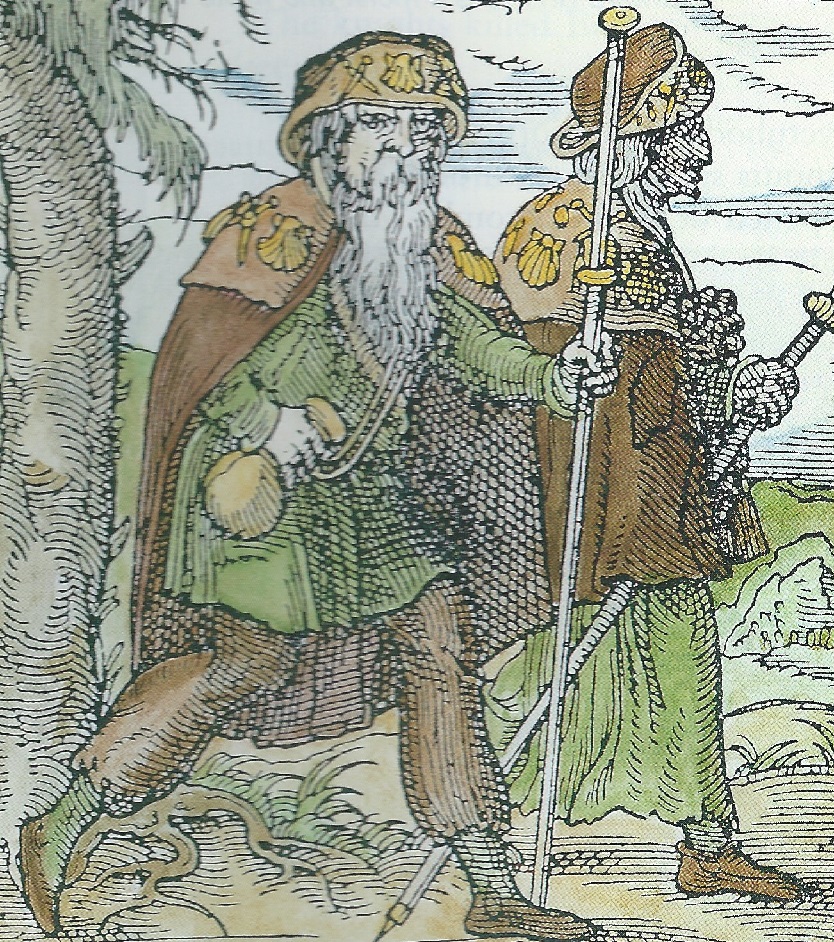
Medieval Pilgrims

Introduction
In the Middle Ages, priests taught people to believe in purgatory, a place where people's sins were burned out of their souls after they had died. It was said that the fires burning there were as fierce as those in hell.
To please God, and to avoid years of torment in purgatory, people went on a pilgrimage. The most adventurous pilgrims went to Jerusalem, to see the Holy Land where Jesus had lived. Others went to Rome, where the Pope lived (these pilgrims were called 'roamers'). Most went to the shrine of a local saint, closer to home.
By the later Middle Ages, the Pilgrim routes resembled the modern tourism industry. For a fee, medieval agents similar to our modern tour operators would arrange your pilgrimage and act as guides. The Knights Templars had a banking system whereby you could pay in your money in England, and take it out anywhere in Europe. Hospices and hospitals along the way offered lodgings to the travellers. Each shrine actively promoted its 'brand', and sold its own religious badges and 'souvenirs' to the visitors.
For some people – in a world where travel was difficult and dangrous – a pilgrimage was the only time in their life when they left their local area and saw something of the wider world.
Study these Sources, then answer the question sheet by clicking on the 'Time to Work' icon at the top of the page.
Links:
The following websites will help you research further:
Medieval Pilgrimages:
•
BBC video
• Spartacus site - advanced
1 A Pilgrim
This description of a typical pilgrim comes from William Langland's Piers the Ploughman (c.1362).
He carried a staff • with a wide strip of cloth,
Like a bindweed plant • twisted around it.
A bag and a bowl • hung from his belt;
A hundred bottles of holy oil • upon his hat.
And other souvenirs • shells from Spain,
Many a cross on his cloak • and keys from Rome
And a St Veronica handkerchief • so people might know,
And see by these signs • which shrines he had seen.
2 The Jacob Brothers
These pilgrims wear rough clothes and carry staffs. Which shrine have they just visited?

3 Chaucer's Canterbury Pilgrims

Many English people went to the shrine of St Thomas à Becket at Canterbury in Kent. They often travelled in groups, for company and safety.
Chaucer's famous Canterbury Tales (c.1387) was based around the idea of such a group of pilgrims travelling to Canterbury, and telling tales to entertain each other along the way, as Chaucer explains in his prologue:
"Befell that, in that season, on a day
In Southwark, at The Tabard, as I lay
Ready to start upon my pilgrimage
To Canterbury, full of devout homage,
There came at nightfall to that hostelry
Some nine and twenty in a company
Of sundry persons who had chanced to fall
In fellowship, and pilgrims were they all."
In fact, most of Chaucer's pilgrims were very ungodly, and the Canterbury Tales was more 'Big Brother' than 'Songs of Praise'.
One visitor to Rome
One visitor to Rome in 1510 was a godly young German monk called Martin Luther. When he first saw Rome in the distance he fell on his knees and cried 'Hail, holy Rome!', and at first he ran round 'like a crazy saint' visiting all the churches and shrines.
But he soon became horrified at what he saw. Priests rushed through the Mass as quickly as possible, mocked the bread and wine, boasted about how they fleeced the visitors, and openly admitted they they believed nothing of it themselves. The young Luther was horrified. He decided that 'if there is a hell, Rome is built on it' and wrote that: 'Rome is a pit that sends forth all kinds of sins'.
He returned to Germany where, seven years later, he started a Reformation which ended up with most of northern Europe breaking away from the Roman Catholic Church.